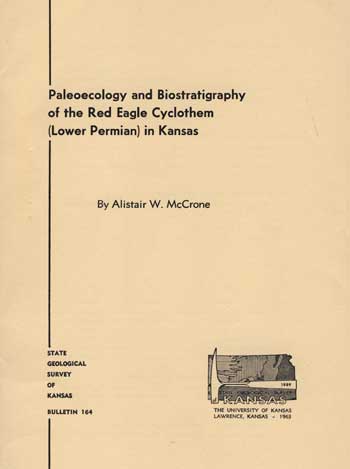Paleoecology and Biostratigraphy of the Red Eagle Cyclothem (Lower Permian) in Kansas
by Alistair W. McCrone

Originally published in 1963 as Kansas Geological Survey Bulletin 164. This is, in general, the original text as published in 1963. The information has not been updated.
Abstract
The Red Eagle cyclothem, a Lower Permian (Wolfcamplan) marine sedimentary rock succession, includes, in ascending order, rocks of the Johnson Shale, Red Eagle Limestone, and Roca Shale. Despite facies changes, these and the component stratigraphic units can be traced along their outcrop belt southward from Lincoln, Nebraska, across Kansas to Burbank, Oklahoma.
Detailed stratigraphy,, sedimentary petrography, and paleontology of the Red Eagle cyclothem provide the bases for interpretations of its depositional environments and its plant and animal megafossils and microfossils. Postulates concerning the approximate physical and chemical characteristics of the Red Eagle cyclothem marine environments are advanced. The assembled evidence suggests that the depositional environments of the various faunal-lithologic phases of this and other Lower Permian cyclothems were most directly controlled by marine water depths which ranged from 0 to scarcely more than 60 feet. Other combined factors sometimes were more important than or modified the depth effects.
The Red Eagle cyclothem sediments accumulated in a broad, shallow epicontinental sea, the floor of which was flattest during accumulation of the oldest part of the Red Eagle Limestone. Slight changes of water depth caused widespread changes in depositional conditions.
The accumulation of red mud in very shallow water began the Red Eagle cyclothemic succession in the middle part of Johnson time and concluded it near the middle of Roca time. Muddy depositional conditions which produced the Johnson Shale were similar to those which later produced the Roca Shale. Limestones of the Red Eagle Formation, and their shaly equivalents, accumulated In slightly deeper waters.
Faint upwarps of the earth's crust in the Nemaha Arch and contiguous areas of east-central Kansas seem to have influenced water circulation and thereby exercised minor control over the accumulation of sediments in the Red Eagle Limestone.
Fossil spores found in the Red Eagle cyclothem seem similar to somewhat younger Permian floral assemblages from other parts of the world.
Ten fundamental faunal-lithologic facies types are recognized in the Red Eagle cyclothem. Most of these facies are also represented in other Kansas cyclothems.
Kansas Geological Survey, Geology
Placed on web Jan. 4, 2007; originally published Dec. 1963.
Comments to webadmin@kgs.ku.edu
The URL for this page is http://www.kgs.ku.edu/Publications/Bulletins/164/index.html